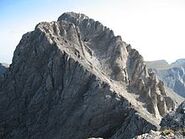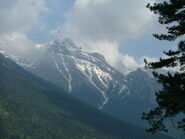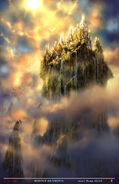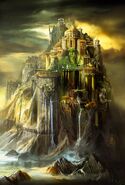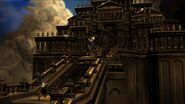Mount Olympus (/oʊˈlɪmpəs, ə-/; Greek: Όλυμπος Olympos, for Modern Greek also transliterated Olimbos, [ˈolimbos] or [ˈolibos]) is the highest mountain in Greece. It is located in the Olympus Range on the border between Thessaly and Macedonia, between the regional units of Pieria and Larissa, about 80 km (50 mi) southwest from Thessaloniki. Mount Olympus has 52 peaks, deep gorges, and exceptional biodiversity. The highest peak, Mytikas, meaning "nose", rises to 2,918 metres (9,573 ft). It is one of the highest peaks in Europe in terms of topographic prominence.
Olympus was notable in Greek mythology as the home of the Greek gods, on the Mytikas peak. Mount Olympus is also noted for its very rich flora, with several species. It has been a National Park, the first in Greece, since 1938. It is also a World Biosphere Reserve.
Every year, thousands of people visit Olympus to admire its fauna and flora, tour its slopes, and reach its peaks. Organized mountain refuges and various mountaineering and climbing routes are available to visitors who want to explore it. The usual starting point is the town of Litochoro, on the eastern foothills of the mountain, 100 km from Thessaloniki, where, in the beginning of every summer, the Olympus Marathon terminates.
Geography[]
The shape of Olympus was formed by rain and wind, which produced an isolated tower almost 3,000 metres (9,800 ft) above the sea, which is only 18 kilometres (11 mi) away at Litochoro. Olympus has many peaks and an almost circular shape. The mountain has a circumference of 150 kilometres (93 mi), an average diameter of 26 kilometres (16 mi), and 500 square kilometres (190 sq mi) of area. To the northwest lies the Vlach village of Kokkinoplou. The Makryrema stream separates Olympus from the massif of Voulgara. The villages Petra, Vrontou and Dion lie to the northwest, while on the eastern side there is the town of Litochoro, where Enipeas bisects the massif of Olympus. On its southeastern side, the Ziliana gorge divides Mount Olympus from Kato Olympos (Lower Olympus), while on its southwestern foothills, there are the villages Sykaminea and Karya. The Agia Triada Sparmou Monastery and the village Pythion lie to the west.
Olympus' dry foothills, known as the Xirokampi, are covered in chaparral and provides habitat for animals such as wild boar. Further east, the plain of Dion is fertile and watered by the streams which originate on Olympus.
Geology[]
Mount Olympus is formed of sedimentary rock laid down 200 million years ago in a shallow sea. Various geological events that followed caused the emergence of the whole region and the sea. Around one million years ago glaciers covered Olympus and created its plateaus and depressions. With the temperature rise that followed, the ice melted and the streams that were created swept away large quantities of crushed rock in the lowest places, forming the alluvial fans, that spread out all over the region from the foothills of the mountain to the sea. The Geological Museum of Mount Olympus, located in Leptokarya, provides detailed information about the geological structure of the mountain.
Morphology[]
The complicated geological past of the region is obvious from the morphology of Olympus and its National Park. Features include deep gorges and dozens of smooth peaks, many of them in altitude of more than 2,000 metres (6,600 ft), including Aghios Antonios (2,815 metres (9,236 ft)), Kalogeros (2,700 metres (8,900 ft)), Toumpa (2,801 metres (9,190 ft)) and Profitis Ilias (2,803 metres (9,196 ft)). However, it is the central, almost vertical, rocky peaks, that impress the visitor. Over the town of Litochoro, on the horizon, the relief of the mountain displays an apparent V, between two peaks of almost equal height. The left limb is the peak named Mytikas (or Pantheon – 2,918 metres (9,573 ft)). It is Greece's highest peak. Then, on the right is Stefani (or Thronos Dios [Throne of Zeus – 2,902 metres (9,521 ft)]), which presents the most impressive and steep peak of Olympus, with its last sharply rising 200 meters presenting the grea challenge for climbers. Further south, Skolio (40.0829°N 22.3571°E second highest peak – 2,912 metres (9,554 ft)) completes an arc of about 200 degrees, with its steep slopes forming on the west side, like a wall, an impressive precipitous amphitheatrical cavity, 700 metres (2,300 ft) in depth and 1,000 metres (3,300 ft) in circumference, the 'Megala Kazania'. On the east side of the high peaks the steep slopes form zone like parallel folds, the 'Zonaria'. Even narrower and steeper scorings, the 'Loukia', lead to the peak.
Οn the north side, between Stefani and Profitis Ilias, extends the Muses' Plateau, at 2,550 metres (8,370 ft), while further south, almost in the center of the massif, extends the alpine tundra region of Bara, at an altitude of 2,350 metres (7,710 ft). Olympus has numerous ravines and gullies. Most distinguishable of the ravines are those of Mavrologos-Enipeas (14 km) and Mavratzas-Sparmos (13 km) near Bara and 'cut' the massif in two oval portions. On the southern foothills the great gorge of Ziliana, 13 km long, consists of a natural limit that separates the mountain from Lower Olympus. There are also many precipices and a number of caves, even nowadays unexplored. The form and layout of the rocks favor the emergence of numerous springs, mainly lower than 2,000 m, of small seasonal lakes and streams and of a small river, Enipeas, with its springs in the site Prionia and its estuary in the Aegean Sea.
Name and mythological associations[]
The origin of the name Όλυμπος Olumpos is unknown and usually considered of "pre-Greek" origin. In Homeric Greek (Odyssey 6.42), the variant Οὔλυμπος Oulumpos occurs, conceived of as the seat of the gods (and not identified with any specific peak). Homer (Iliad 5.754, Odyssey 20.103) also appears to be using οὔλυμπος as a common noun, as a synonym of οὐρανός ouranos "sky". Mt Olympus was historically also known as Mount Belus, after Iliad 1.591, where the seat of the gods is referred to as βηλ[ός] θεσπεσίο[ς] "heavenly threshold".
In Ancient Greek religion and mythology, "Olympus" was the name of the home of the Twelve Olympian gods of the ancient Greek world. This was conceived of as a lofty mountaintop, and in all regions settled by Greek tribes, the highest local elevation tended to be so named; among the numerous peaks called Olumpos in antiquity are mountains in Mysia, Laconia, Lycia, Cyprus, Attica, Euboea, Ionia and Lesbos, and others. Thessalian Olympus is the highest peak in any territory with Greek settlement and came to be seen as the "Pan-Hellenic" representative of the mythological seat of the gods, by at least the 5th century BC, as Herodotus (1.56) identifies Olympus as the peak in Thessaly.
In Pieria, at Olympus's northern foot, the mythological tradition had placed the nine Muses, patrons of the Fine Arts, daughters of Zeus and the Titanide Mnemosyne.
History[]
In antiquity, the Olympus massif forms the border between Thessaly and Macedon. The history of the surrounding area is consequently of interest in the context of the Rise of Macedon, the Chremonidean War and the Macedonian Wars during the 4th to 2nd centuries BC. In the period of the Ottoman Empire the mountain was a hiding place and base of operations for klephts and armatoloi. It was known as Semavatevi in Turkish during the nearly 400 years of Ottoman rule.
In Olympus, the second armatoliki was founded, led by Kara Michalis in 1489. The action of the klephts in Olympus led the Turks to visit their outrage on the klephts' ally-village of Milia (in the late 17th century), which they destroyed. In that period Livadi in Olympus became the seat of the armatoliki of Olympus and Western Macedonia, with their first renowned commander Panos Zidros. In the 18th century the Turks had to replace the armatoloi (who very often joined the klephts) with Moslem Albanian armatoloi who ravaged the countryside of Macedonia. However, Olympus' armatoloi, even after their capitulation to Ali Pasha, never ceased fighting on land and at sea. Among them who were active there and in nearby regions were Nikotsaras, Giorgakis Olympios and the legendary family of Lazaioi. In the early 20th century, even for some time after the liberation from the Ottoman Empire (1912), robbers were active in the region – the best known of them the notorious Giagoulas, while during the German invasion in 1941 the Greek army fought significant battles along with units of New Zealanders and Australians. During the German Occupation (1941–1944) the mountain was one of the centers of the Greek Resistance, while a little later the Greek Civil War (1946–49) started there, in Litochoro.
Ancient and medieval sites[]
The whole region of Pieria's Olympus was declared archaeological and historical site for the preservation of its monumental and historical character. Five km away from the sea is Dion, sacred city of the ancient Macedons, dedicated to Zeus and the Twelve Olympians. Its prosperity lasted from the 5th century BC to the 5th century AD The excavations, continuing since 1928, have revealed numerous findings of the Macedonian, the Hellenistic and the Roman period. Currently there is a unique archaeological park of 200 hectares, with the ancient town and the sacred places of worship, outside its walls. Many statues and other invaluable items are kept in the nearby Dion's archaeological museum. Pimblia and Leivithra, two other towns in Olympus' region, are related to Orpheus and the "Orphic" mysteries. According to a tradition Orpheus, son of Apollo and Calliope (one of the Muses), taught here the mystic ceremonies of worship of Dionysus (also known as Bacchus). By the sea, in a strategic position, at Macedonia's gates is located Platamon Castle, built between 7th and 10th century AD in the ancient town of Heracleia. To the north the ancient Pydna is located. Here, in 168 BC, the decisive battle between the Macedonians and the Romans took place. Between Pydna and Mount Olympus are a fortified bishops seat from the Byzantine period called Louloudies and the Macedonian Tombs of Katerini and Korinos.
Christian monuments[]
In the Olympus region, there are also several Christian monuments, among them the highest-altitude chapel of Orthodox Christianity, dedicated to Prophet Elias, in Greek tradition associated with mountaintops, on the summit of the same name (Προφήτης Ηλίας Profitis Ilias), at 2,803 m. It was built in the 16th century by Saint Dionysios of Olympus, who also founded the most significant monastery in the region. The Old Monastery of Dionysios (altitude 820 m) lies in Enipeas' gorge and is accessible by car from Litochoro. It was looted and burned by the Ottomans and in 1943 it was destroyed by the German invaders, who suspected it was a guerilla den. Nowadays it has been partially restored and operates as a dependency of the New Monastery of Dionysios, that is outside Litochoro. On Olympus' southern foot, in a dominant position (820 m) in Ziliana gorge, there is the Kanalon Monastery, 8 km away from Karya. It was founded in 1055 by the monks Damianos and Joakim and since 2001 it has been restored and operates as a convent. Further west, in the edge of Mavratza stream, at 1,020 m, there is the Agia Triada Sparmou Monastery, that flourished in the early 18th century, possessed great property and assisted to establish the famous Tsaritsani' school. It was abandoned in 1932, but in 2000 it was completely renovated and reopened as a male monastery, affiliated to Elassona's diocese.
Climbing expeditions[]
The third highest peak of Mt Olympus, called Agios Antonios (Άγιος Αντώνιος "Saint Anthony", 40.0677°N 22.3511°E, 2,817 m), is known to have been the site of a sanctuary of Zeus in antiquity based on archaeological finds discovered in 1961. In the modern era, a series of explorers tried to study the mountain and to tried to reach its summit. Examples include the French archaeologist Leon Heuzey (1855), the German explorer Heinrich Barth (1862), and the German engineer Edward Richter. Richter tried to reach the summit in 1911 but was abducted by klephts, who also killed the Ottoman gendarmes that accompanied him.
It was just one year after the liberation of Greece from Ottoman rule, on 2 August 1913, that the summit of Olympus was finally reached. The Swiss Frédéric Boissonnas and Daniel Baud-Bovy, aided by a hunter of wild goats from Litochoro, Christos Kakkalos, were the first to reach Greece's highest peak. Kakkalos, who had much experience climbing Olympus, was the first of the three to climb Mytikas. Afterwards, and till his death in 1976, he was the official guide on Olympus. In 1921, he and Marcel Kurz reached the second highest summit of Olympus, Stefani. Based on these explorations, Kurz in 1923 edited Le Mont Olympe, a book that includes the first detailed map of the summits. In 1928, the painter Vasilis Ithakisios climbed Olympus together with Kakalos, reaching a cave that he named Shelter of the Muses, and he spent many summers painting views of the mountain. Olympus was later photographed and mapped in detail by others, and a series of successful climbs and winter ascents of the steepest summits in difficult weather conditions took place.
Climbing Mount Olympus is a non-technical hike, except for the final section from the Skala summit to the Mytikas peak, which is a YDS class 3 rock scramble. It is estimated that 10,000 people climb Mount Olympus each year, most of them reaching only the Skolio summit. Most climbs of Mount Olympus start from the town of Litochoro, which took the name City of Gods because of its location at the foot of the mountain. From there a road goes to Prionia, where the hike begins at the bottom of the mountain.
Inhabitants[]
- Zeus - King of the gods and God of Thunder.
- Hera - Queen of the gods and Goddess of Marriage.
- Poseidon - God of the Sea.
- Demeter - Goddess of the Harvest.
- Apollo - God of the Sun.
- Artemis - Goddess of the Hunt.
- Ares - God of War.
- Aphrodite - Goddess of Love.
- Hephaestus - God of Blacksmiths.
- Athena - Goddess of Wisdom.
- Hermes - Messenger of the gods and God of Travelers.
- Hebe - Cupbearer to the gods and Goddess of Youth.
- Heracles - Gatekeeper of Olympus and God of Strength.
- Eris - Goddess of Discord.
- Eileithyia - Goddess of Childbirth.
- Dionysus - God of Wine.
- Enyo - Goddess of War.
- Eros - God of Love.
- Hestia - Goddess of the Hearth.
- Pan - God of Shepards.
- Hygieia - Goddess of Health.
- Janus - God of Doorways.
- Iris - Goddess of the Rainbow.
- Eirene - Goddess of Peace.
Locations[]
- Olympus' Garden
- Olympia
- Icarus Vent
- Labyrinth
- Zeus' Throne Room
- Chamber of the Flame of Olympus
- Zeus and Hera's Chamber
- Poseidon's Chamber
- Aphrodite's Chamber
- Ares' Chamber
- Arena
- Hyperion Gates
- Caverns of Olympus
- Caves of Olympus
- Heracles and Hebe's Chamber
In Popular Culture[]
Films[]
- Mount Olympus appears in the 2010 film Clash of the Titans.
Video games[]
- Mount Olympus appears in Clash of the Titans: The Videogame.
- Mount Olympus Appears In The God Of War Video Game Series

